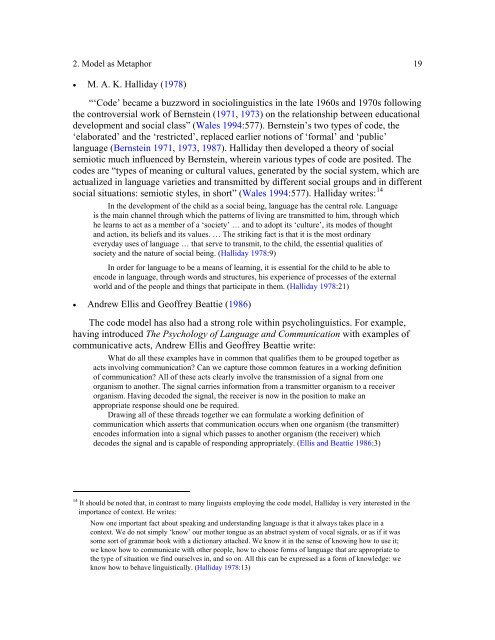The code model of communication: a powerful - SIL International
The code model of communication: a powerful - SIL International
The code model of communication: a powerful - SIL International
You also want an ePaper? Increase the reach of your titles
YUMPU automatically turns print PDFs into web optimized ePapers that Google loves.
2. Model as Metaphor 19<br />
• M. A. K. Halliday (1978)<br />
“‘Code’ became a buzzword in sociolinguistics in the late 1960s and 1970s following<br />
the controversial work <strong>of</strong> Bernstein (1971, 1973) on the relationship between educational<br />
development and social class” (Wales 1994:577). Bernstein’s two types <strong>of</strong> <strong>code</strong>, the<br />
‘elaborated’ and the ‘restricted’, replaced earlier notions <strong>of</strong> ‘formal’ and ‘public’<br />
language (Bernstein 1971, 1973, 1987). Halliday then developed a theory <strong>of</strong> social<br />
semiotic much influenced by Bernstein, wherein various types <strong>of</strong> <strong>code</strong> are posited. <strong>The</strong><br />
<strong>code</strong>s are “types <strong>of</strong> meaning or cultural values, generated by the social system, which are<br />
actualized in language varieties and transmitted by different social groups and in different<br />
social situations: semiotic styles, in short” (Wales 1994:577). Halliday writes: 14<br />
In the development <strong>of</strong> the child as a social being, language has the central role. Language<br />
is the main channel through which the patterns <strong>of</strong> living are transmitted to him, through which<br />
he learns to act as a member <strong>of</strong> a ‘society’ … and to adopt its ‘culture’, its modes <strong>of</strong> thought<br />
and action, its beliefs and its values. … <strong>The</strong> striking fact is that it is the most ordinary<br />
everyday uses <strong>of</strong> language … that serve to transmit, to the child, the essential qualities <strong>of</strong><br />
society and the nature <strong>of</strong> social being. (Halliday 1978:9)<br />
In order for language to be a means <strong>of</strong> learning, it is essential for the child to be able to<br />
en<strong>code</strong> in language, through words and structures, his experience <strong>of</strong> processes <strong>of</strong> the external<br />
world and <strong>of</strong> the people and things that participate in them. (Halliday 1978:21)<br />
• Andrew Ellis and Ge<strong>of</strong>frey Beattie (1986)<br />
<strong>The</strong> <strong>code</strong> <strong>model</strong> has also had a strong role within psycholinguistics. For example,<br />
having introduced <strong>The</strong> Psychology <strong>of</strong> Language and Communication with examples <strong>of</strong><br />
communicative acts, Andrew Ellis and Ge<strong>of</strong>frey Beattie write:<br />
What do all these examples have in common that qualifies them to be grouped together as<br />
acts involving <strong>communication</strong>? Can we capture those common features in a working definition<br />
<strong>of</strong> <strong>communication</strong>? All <strong>of</strong> these acts clearly involve the transmission <strong>of</strong> a signal from one<br />
organism to another. <strong>The</strong> signal carries information from a transmitter organism to a receiver<br />
organism. Having de<strong>code</strong>d the signal, the receiver is now in the position to make an<br />
appropriate response should one be required.<br />
Drawing all <strong>of</strong> these threads together we can formulate a working definition <strong>of</strong><br />
<strong>communication</strong> which asserts that <strong>communication</strong> occurs when one organism (the transmitter)<br />
en<strong>code</strong>s information into a signal which passes to another organism (the receiver) which<br />
de<strong>code</strong>s the signal and is capable <strong>of</strong> responding appropriately. (Ellis and Beattie 1986:3)<br />
14<br />
It should be noted that, in contrast to many linguists employing the <strong>code</strong> <strong>model</strong>, Halliday is very interested in the<br />
importance <strong>of</strong> context. He writes:<br />
Now one important fact about speaking and understanding language is that it always takes place in a<br />
context. We do not simply ‘know’ our mother tongue as an abstract system <strong>of</strong> vocal signals, or as if it was<br />
some sort <strong>of</strong> grammar book with a dictionary attached. We know it in the sense <strong>of</strong> knowing how to use it;<br />
we know how to communicate with other people, how to choose forms <strong>of</strong> language that are appropriate to<br />
the type <strong>of</strong> situation we find ourselves in, and so on. All this can be expressed as a form <strong>of</strong> knowledge: we<br />
know how to behave linguistically. (Halliday 1978:13)

















